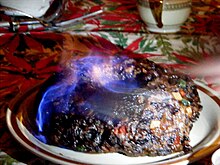Figgy pudding

Figgy Pudding (occasionally Piggy-Pudding) is a vague term used for a class of traditional Christmas dishes usually forming sweet & savory cakes, containing a sour-sweet creamy layer of honey, fruits and nuts.[citation needed] In later times, rum or other distilled alcohol became often added to enrich the fruitfullness of the flavor.
Etymology[]
Medieval cooking commonly employed figs, in both sweet and savoury dishes.[1] One such dish is fygey, in the 14th century cookbook The Forme of Cury, which in Modern English is "figgy", this dish being known as figgy pudding or fig pudding:[2][1][3]
Take Almaende blanched; grynde hem and drawe hem up with watr and wyne; quartr figs hole raisons. Cast þerto powdor gingr and hony clarified; seeþ it wel and salt it, and seve forth.[4] |
Take blanched almonds, grind them, mix with water and wine, quartered figs, whole raisins. Add in powdered ginger, clarified honey, boil it well and salt it, and serve.[5] |
| —The Forme of Cury recipe 118 |
The Middle English name had several spellings, including ffygey, fygeye, fygee, figge, and figee.[6][7][8] The latter is a 15th century conflation with a different dish.[7] Figee was in fact a dish of fish and curds, which was named figé in Old French, meaning "curdled" (the past participle of the Old French figer).[7][6][9] But it too came to mean a "figgy" dish, involving cooked figs, boiled in wine or otherwise.[7] A turn of the 15th century herbal has a recipe for figee:
Nym figes, & boille hem in wyn, & bray hem in a morter with lied bred; tempre hit vp with goud wyn / boille it / do therto good spicere, & hole resons / dresse hit / florisshe it a-boue with pomme-garnetes.[10] |
Take figs and boil them in wine, and pound them in a mortar with bread. Mix it up with good wine; boil it. Add good spices and whole raisins. Dress it; decorate it with pomegranate seeds on top.[11] |
| —Laudian Manuscript 553, Bodleian Library |
Liber Cure Cocorum has the recipe under the name "fignade" on page 42.[6][8] Richard Warner's Antiquitates Culinariae has it under the name "fyge to potage".[6][12][8] Mrs Beeton's Book of Household Management contains two different recipes for fig pudding that use suet, numbers 1275 and 1276.[13]
Popular culture[]
Often associated with the original traditions of Christmas, it is most notably referred to in the Christmas carol "We Wish You a Merry Christmas" in the line "Now bring us some figgy pudding!".[14] Figgy pudding is not plum pudding, although it can be considered a precursor to it. It is not as rich, nor as complex in its recipe.[2] A number of Christmas markets will offer figgy pudding flavored desserts as part of their range, though the relation of these to the original taste-wise is rather doubtful.
See also[]
References[]
Cross-reference[]
- ^ Jump up to: a b Threlfall-Holmes 2005, p. 61–62.
- ^ Jump up to: a b Breverton 2015, p. 236.
- ^ Hieatt, Nutter & Holloway 2006, p. 113.
- ^ Pegge 2014, p. 45.
- ^ Albala 2006, p. 65.
- ^ Jump up to: a b c d Austin 1888, p. 129.
- ^ Jump up to: a b c d Shipley 1955, p. 267.
- ^ Jump up to: a b c Hieatt, Nutter & Holloway 2006, p. 38.
- ^ Morton 2004, p. 51.
- ^ Austin 1888, p. 113.
- ^ Ayto 2012, p. 133.
- ^ Warner 1791, p. 67.
- ^ Beeton 2006, p. 618.
- ^ Cassidy 2004, p. 48.
Reference bibliography[]
- Albala, Ken (2006). "The Middle Ages 1300–1450". Cooking in Europe, 1250–1650. Daily life through history. Greenwood Publishing Group. ISBN 9780313330964. ISSN 1080-4749.
- Ayto, John (2012). "figee". The Diner's Dictionary: Word Origins of Food and Drink. Oxford University Press. ISBN 9780199640249.
- Austin, Thomas (1888). Two Fifteenth-Century Cookery-Books. N. Trübner & Co. (Two Fifteenth-Century Cookery-Books at the Internet Archive)
- Beeton, Isabella (2006). Mrs Beeton's Household Management. Wordsworth Editions. ISBN 9781840222685.
- Breverton, Terry (2015). "Sweets". The Tudor Kitchen: What the Tudors Ate & Drank. Amberley Publishing Limited. ISBN 9781445648750.
- Cassidy, Jennie (December 2004). "Now bring us some figgy pudding!". Early Music Review. King's Music. 104. ISBN 9783761815946.
- Hieatt, Constance Bartlett; Nutter, Terry; Holloway, Johnna H. (2006). Concordance of English Recipes: Thirteenth Through Fifteenth Centuries. Medieval & Renaissance Texts Studies. 312. ACMRS. ISBN 9780866983570.
- Morton, Mark (2004). "bouce Jane". Cupboard Love 2: A Dictionary of Culinary Curiosities. Insomniac Press. ISBN 9781897415931.
- Pegge, Samuel, ed. (2014). The Forme of Cury, a Roll of Ancient English Cookery. Cambridge University Press. ISBN 9781108076203.
- Shipley, Joseph T. (1955). "figee". Dictionary of Early English. Rowman & Littlefield. ISBN 9781442233997.
- Threlfall-Holmes, Miranda (2005). Monks and Markets: Durham Cathedral Priory 1460–1520. Oxford University Press. ISBN 9780199253814.
- Warner, Richard (1791). Antiquitates Culinariae, Or Curious Tracts Relating to the Culinary Affairs Of The Old English. London: R. Blamire.
| Wikibooks Cookbook has a recipe/module on |
- British puddings
- Fig dishes